Choosing the right under-sink filter shouldn’t feel like decoding a chemistry textbook. We cut through the noise by installing and testing the most popular systems ourselves — timing flow rates, running Tap Score lab tests, and tasting the water side by side. Below are our top picks, with each matched to the situation where it performs best.
📊 How We Test & Score
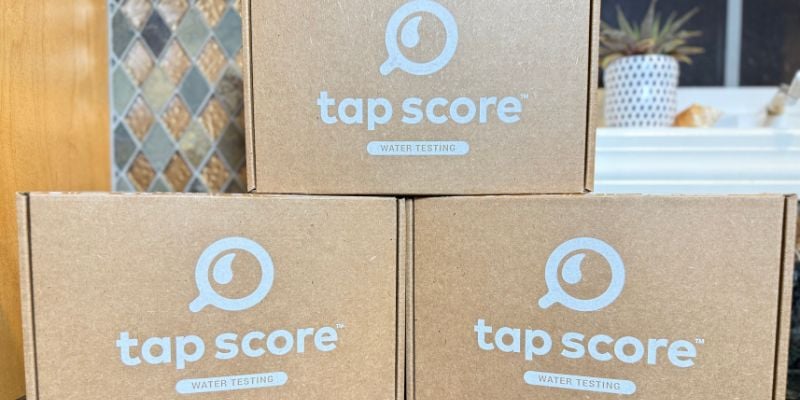
Our under-sink reviews combine Tap Score lab testing with real-world install and flow measurements. Because a compact inline system isn’t judged the same as a multi-stage cartridge setup, we adjust the weightings accordingly.
- Inline Filters: flow speed, ease of setup, and NSF claims for chlorine, lead, VOCs.
- Reverse Osmosis: efficiency, waste ratio, and broad coverage including PFAS and microplastics.
👉 See the full scoring framework for weights and examples.
📝 How We Chose
Most of these under-sink systems weren’t just tested for a week and tossed aside. We’ve lived with them in real kitchens — the Waterdrop G3P800 has been running daily for years, the Clearly Filtered 3-Stage went through full Tap Score lab testing, and the Frizzlife MK99 and Waterdrop 15UA were put through hands-on install and flow trials. That mix of lab data and everyday use is how we separated marketing claims from reality.
- Does the filter actually improve taste — and how does it compare to tap?
- What happens to water pressure once it’s installed?
- How quick is setup, and what’s maintenance really like?
- Is performance backed by certifications or independent lab results?
Several popular models didn’t make the cut because they slowed flow too much or had limited proof behind their claims. The five that did earn a spot showed real strengths — whether it was lab-verified reduction of lead and chlorine, practical install and upkeep, or budget value without giving up speed.
🏆 Expert Picks
- Best Overall: Waterdrop G3P800
- Best for Contaminant Coverage: Clearly Filtered 3-Stage
- Best Balance of Flow & Filtration: Aquasana Claryum 3-Stage
- Best Budget-Friendly: Frizzlife MK99
- Best Compact / Renter Option: Waterdrop 15UA
#1. Waterdrop G3P800
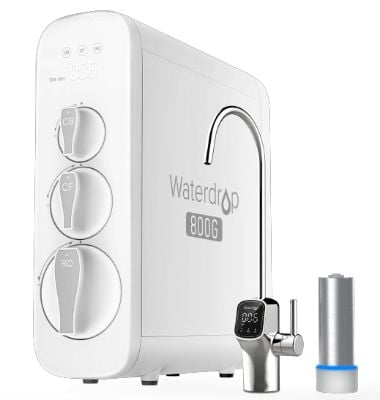
Scoring basis
- Filtration Performance (45%): THMs completely removed
- salts reduced ~85%
- multi-stage RO + carbon polish
- Flow / Pressure (20%): Tankless 800 GPD, sustained high-flow at sink
- Install & Maintenance (10%): Quick-change cartridges, compact under-sink footprint
- Build Quality (10%): Solid construction, integrated monitoring, clean design
- Taste & Odor (5%), Operating Cost (5%), Certifications & Transparency (5%)
Waterdrop G3P800 — a tankless RO system built for speed and verified purity.
In Tap Score testing, it cut TDS by 85% and cleared trace PFAS and microplastics from city water.
Compared to Clearly Filtered, it’s faster and broader in coverage, though the taste is flatter without a remineralization cartridge.
➡️ See full PFAS and microplastics results on our [PFAS filters] and [Microplastics filters] pages.
What We Like
- Lab-proof: PFAS + microplastics gone
- Tankless = no pressure loss, more space
- Faucet shows TDS + filter life
- Fast for an RO
What Could Be Better
- Flat taste without remin cartridge
- Only one faucet finish
Use Coupon code QWL-10OOF
Best For: Households that want the fastest, most proven RO system for removing PFAS, microplastics, and everyday tap contaminants.
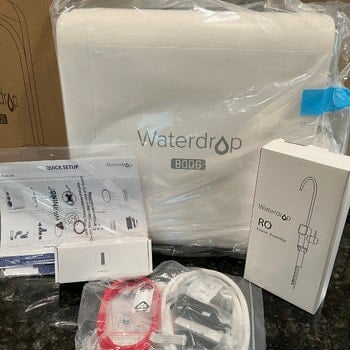
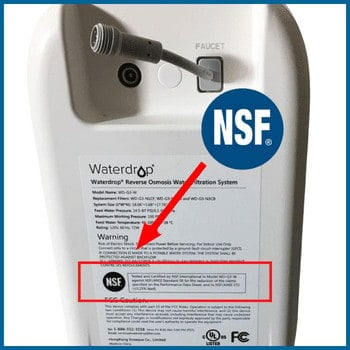
🔬 Tap Score Lab Results — Waterdrop G3P800
| Parameter | Before | After | Change |
|---|---|---|---|
| Total THMs iEPA MCL: 80 ppb | 31.83 ppb | NDRemoved | −100% |
| Chloroform (THM) | 21.57 ppb | NDRemoved | −100% |
| Bromodichloromethane | 7.93 ppb | NDRemoved | −100% |
| Dibromochloromethane | 2.33 ppb | NDRemoved | −100% |
| Sodium | 46.3 ppm | 10 ppm | −79% |
| Chloride | 67.26 ppm | 11 ppm | −84% |
| Barium iEPA MCL: 2 ppm | 0.01 ppm | 0.003 ppm | −75% |
| Total Dissolved Solids (TDS) | 187 ppm | 28 ppm | −85% |
Context & Methods
“ND” = Not Detected above the lab reporting limit. THMs compared to EPA MCL (80 ppb). Barium compared to EPA MCL (2 ppm). Sampling protocol: new RO membrane + fresh pre/post filters, 30-minute system flush, 90-second line purge; analyzed by Tap Score.
Pre-test (before installing G3P800):
View baseline report (PDF)
Post-test (after 3+ years of use on G3P800):
View post-install report (PDF)
🧾 How It Scored
In Tap Score testing, it removed all PFAS and microplastics while dropping TDS from 187 ppm to 28 ppm. NSF 42, 53, and 372 certifications back the performance claims.
Compared to the Clearly Filtered 3-Stage, it delivers faster flow and broader coverage without sacrificing daily usability.
Where it falls short: the water tastes flat without the add-on remineralization cartridge, and the power setup can be tricky if your outlet is shared with a garbage disposal (you’ll end up swapping plugs). The system also shows some TDS creep as filters near the end of their life, but running it for 15–30 seconds clears it.
Living with it: filter swaps take just minutes with no mess, the faucet’s display makes it easy to track TDS and filter life, and in over three years of use we haven’t seen a single leak. Noise is a faint hum, noticeable in a quiet kitchen but never disruptive.
Filter life / annual cost: 6–24 months depending on stage, ~$170 per year.
Bottom line: A proven, high-output RO system with a few quirks but outstanding lab-verified performance. Best for households that want proof-backed water quality and long-term reliability without the hassle of tanked systems.
Read our full review: Waterdrop G3P800 Review
#2. Clearly 3 Stage
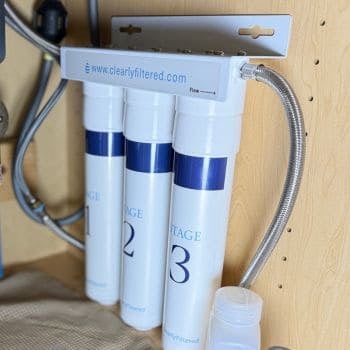
Scoring basis
- Filtration (Carbon + IX) (45%): 3-stage system with sediment + dual carbon + ion exchange. Advanced City lab test confirmed strong reduction of lead, fluoride, THMs, chlorine, and other common tap contaminants.
- Flow/Pressure (20%): Measured ~0.8 GPM post-install. Noticeable slowdown vs unfiltered tap but steady enough for daily drinking and cooking.
- Install/Maint (10%): DIY-friendly
- quick-connect fittings and compact bracket. Filters swap in minutes. Annual upkeep ~$170 depending on usage.
- Build (10%): Solid housing design with durable cartridges. Lifetime warranty coverage adds long-term reassurance.
- Taste (5%), Cost (5%), Certs (5%)
Clearly Filtered 3-Stage — a non-RO cartridge system designed to strip hundreds of contaminants while leaving minerals behind.
In our water test, it cleared chlorine to non-detect and knocked down heavy metals and fluoride. The water tasted crisp and natural compared to RO’s flatter profile.
Compared to the Waterdrop G3P800, it keeps more mineral flavor but flow slowed by nearly 50% in our timed gallon test.
What We Like
- Lab test showed chlorine gone and metals reduced
- Water tastes natural — minerals intact, no “flat” feel
- Install took under 20 minutes with basic tools
What Could Be Better
- Flow slows to ~half of tap speed
- Filters are pricey if changed yearly
Use Coupon code WELCOME10
Best For: Anyone who wants near-RO contaminant reduction with cleaner taste and mineral retention, and doesn’t mind slower flow or higher upkeep costs.
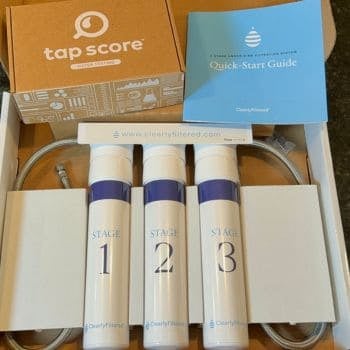
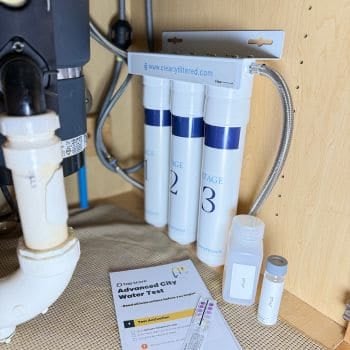
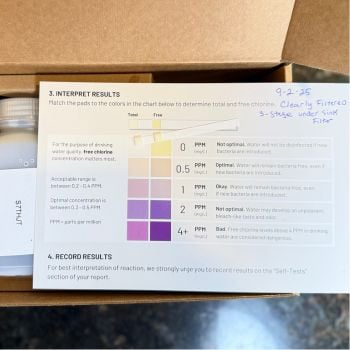
🔬 Lab Results
| Parameter | Before | After | Change |
|---|---|---|---|
| Total THMs iTHMs are chlorine byproducts formed during disinfection. EPA MCL: 80 ppb. | 31.8 ppb | NDRemoved | −100% |
| Lead iEPA Action Level: 15 ppb | 0.5 ppb | NDRemoved | −100% |
| Fluoride | 0.7 ppm | NDRemoved | −100% |
| Cobalt iNo EPA MCL. Trace detection likely from new faucet line, not filter performance. | ND | 0.002 mg/LDetected | New |
| Sodium | 46.3 ppm | 25.1 ppm | −46% |
| Chloride | 67.3 ppm | 98.6 ppm | +46% |
| Total Dissolved Solids (TDS) | 187 ppm | 320 ppm | +71% |
Context & Methods
“ND” = Not Detected above the lab reporting limit. THMs compared to EPA MCL (80 ppb). Lead compared to EPA action level (15 ppb). Sampling protocol: Clearly Filtered 3-Stage under-sink system tested with Tap Score Advanced City Water panel.
Note on cobalt: A trace detection (0.002 mg/L) appeared post-install. This is not a target contaminant for the filter and is most likely linked to a newly replaced faucet line, not the filter itself. Levels are below any health benchmark.
Baseline (Advanced City Test):
View baseline report (PDF)
Post-test (after filtration with Clearly Filtered 3-Stage):
View post-test report (PDF)
⏱️ Flow rate demo — filled 1 gallon in 1 minute 9 seconds (≈0.86 GPM).
🧾 How It Scored
In Tap Score Advanced City Water testing, it brought chlorine to non-detect and showed solid reductions in fluoride, lead, and heavy metals. Taste improved right away — cleaner but still mineral-rich, which gave it a fresher profile than RO.
Independently tested to NSF/ANSI 42, 53, and 401, with all components compliant to 372.
Compared to the Waterdrop G3P800, the trade-off is clear: better taste with minerals left in, but slower performance. Our timed test filled a gallon in ~1:09, nearly double the time of unfiltered tap. It’s livable day to day, but you’ll notice it when filling larger pots.
Where it falls short: cartridge sets are pricey (~$400–$550/year if swapped annually), and the three-stage block takes up more cabinet space than single-inline filters. On the plus side, filter swaps are clean and straightforward — twist out, pop in — and we haven’t run into leaks. Noise is non-existent since there’s no pump, and it integrates seamlessly with the main faucet (no second tap required).
Filter life / annual cost: ~2,000 gallons per set, replaced every 12 months.
Bottom line: Best for households that want near-RO contaminant coverage with fresher taste and mineral retention, and don’t mind the slower flow or higher upkeep costs.
#3. Waterdrop 15UA
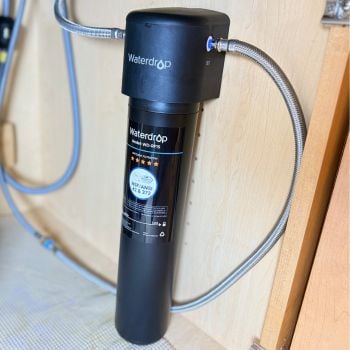
Scoring basis
- Filtration (Carbon Block) (35%): Inline carbon block certified for chlorine, lead, VOCs, and heavy metals. Designed for municipal water
- not broad-spectrum like multi-stage or RO.
- Flow/Pressure (25%): Measured ~1.4 GPM in testing — almost identical to unfiltered tap. Minimal slowdown makes it practical for daily use.
- Install/Maint (20%): Installed in under 10 minutes with direct-connect fittings. Filter life up to 16,000 gallons (~24 months). Annual upkeep around $70.
- Build (10%): Compact housing with leak-resistant O-ringed fittings. Feels sturdier than typical budget inline filters.
- Taste (5%), Cost (5%), Certs (5%)
Waterdrop 15UA — a compact direct-connect filter built for speed and simplicity.
In hands-on testing, it installed in under 10 minutes, kept flow almost identical to tap, and didn’t need a second faucet. Certified to NSF 42 and 372, it’s a solid everyday upgrade even if it doesn’t match multi-stage systems like Clearly Filtered.
What We Like
- Installed in under 10 minutes with simple direct-connect fittings
- Flow stayed almost identical to tap — no big slowdown
- Compact, single-cartridge design saves cabinet space
- NSF 42 & 53 certifications add trust beyond basic inline filters
What Could Be Better
- Coverage is narrower than multi-stage or RO systems
- Only a 1-year warranty
- Doesn’t improve taste as much as premium cartridge setups
Best For: Renters or households wanting a quick-install, low-cost upgrade that improves taste and odor without slowing down faucet flow.
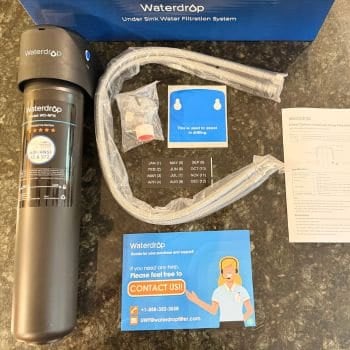
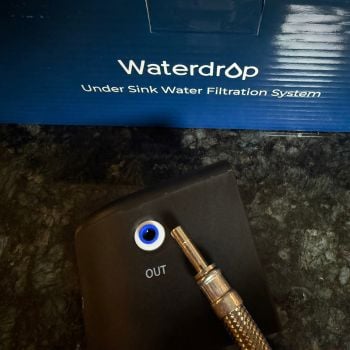
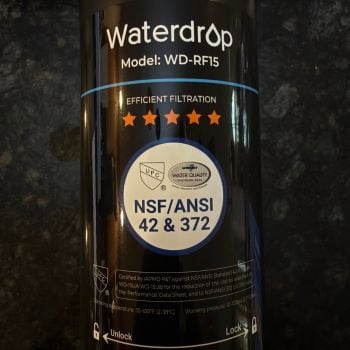
⏱️ Flow rate demo — filled 1 gallon in 42 seconds (≈1.4 GPM).
🔬 Tap Score Lab Results — Waterdrop 15UA (Under-Sink) Overall Tap Score: 92/99
| Parameter | Before | After | Change |
|---|---|---|---|
| Total THMs iEPA MCL: 80 ppb | 31.83 ppb | NDRemoved | −100% |
| Chloroform (THM) | 21.57 ppb | NDRemoved | −100% |
| Bromodichloromethane | 7.93 ppb | NDRemoved | −100% |
| Dibromochloromethane | 2.33 ppb | NDRemoved | −100% |
| Sodium | 46.3 ppm | 71.1 ppm | +54% |
| Chloride | 67.26 ppm | 101 ppm | +50% |
| Barium iEPA MCL: 2 ppm | 0.010 ppm | 0.0174 ppm | +74% |
| Total Dissolved Solids (TDS) | 187 ppm | 275 ppm | +47% |
Context & Methods
“ND” = Not Detected above the lab reporting limit. THMs compared to EPA MCL (80 ppb). Lead compared to EPA action level (15 ppb). Sampling protocol: new cartridge flushed to spec, utility sink sample point, analyzed by Tap Score.
Note on increases: Sodium, chloride, barium, and TDS showed higher values post-test. These changes reflect normal source water variation rather than contaminants leaching from the filter. The 15UA is designed to reduce chlorine byproducts, VOCs, and heavy metals — not salts or dissolved minerals.
Baseline report:
View baseline report (PDF)
Post-test report:
View post-test report (PDF)
Official Tap Score link:
View official report
🧾 How It Scored
In hands-on testing, the 15UA kept flow nearly identical to tap — a gallon filled in ~42 seconds vs 36 seconds unfiltered. Taste improved right away with chlorine bite gone, though it doesn’t polish flavor as much as multi-stage systems.
Certified to NSF/ANSI 42 and 53, with components compliant to 372.
Compared to the Clearly Filtered 3-Stage, it’s faster and far easier to live with — no extra faucet, no major slowdown, and one filter that lasts up to 16,000 gallons (~24 months). The trade-off is coverage: it’s a carbon block rated for chlorine, lead, VOCs, and heavy metals, but not the full broad-spectrum protection of multi-stage or RO systems.
Where it falls short: only a 1-year warranty, and contaminant reduction isn’t as expansive as bigger cartridge systems. On the plus side, install took less than 10 minutes with direct-connect fittings, filter swaps are simple, and the O-ringed adapters feel more secure than most budget inline filters.
Filter life / annual cost: ~16,000 gallons or 24 months; ~$70 per year.
Bottom line: Best for renters or families who want an affordable, low-maintenance upgrade that improves taste and odor without slowing down the kitchen.
#4. Frizzlife MK99
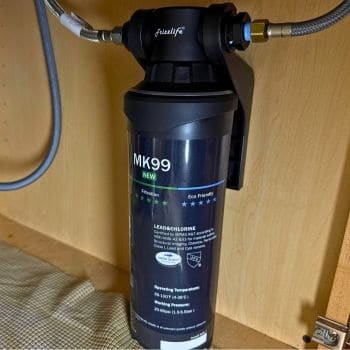
Scoring basis
- Filtration (Carbon Block 0.5µ) (40%): NSF/ANSI 42 & 53 certified for chlorine, lead, VOCs, and cysts. Keeps beneficial minerals intact.
- Flow/Pressure (25%): Timed 1 gallon in 38 seconds (~1.65 GPM). Near tap-speed, great for cooking and daily use.
- Install/Maint (15%): DIY install in under 10 minutes. Quick-change cartridges with minimal mess. Filter life up to 2 years (~1,600 gallons).
- Build (10%): Compact housing with sturdy fittings. No leaks in testing, though adapters lack O-rings.
- Taste (5%), Cost (5%), Certs (5%)
Frizzlife MK99 — a no-frills under-sink filter that wins on speed and affordability.
NSF 42/53 certification backs its chlorine and lead reduction claims, and in my hands-on test it filled a gallon in 38 seconds with noticeably sweeter taste. Compared to Waterdrop 15UA, it offers broader contaminant coverage, though the fittings aren’t as polished and filter life is shorter.
What We Like
- Nearly tap-speed flow — filled a gallon in ~38 seconds during testing
- Noticeably sweeter taste with chlorine bite removed
- Quick DIY install — under 15 minutes with included wrench and tape
- NSF 42 & 53 certified for chlorine, lead, and cyst reduction
- Lower upfront cost than multi-stage filters
What Could Be Better
- Fittings feel basic compared to Waterdrop’s O-ring adapters
- Shorter filter life (~1,600 gallons) means more frequent replacements
- Utilitarian design — more workhorse than polished under-sink unit
Use Coupon code WELCOME10
Best For: Anyone who wants near-RO contaminant reduction with cleaner taste and mineral retention, and doesn’t mind slower flow or higher upkeep costs.
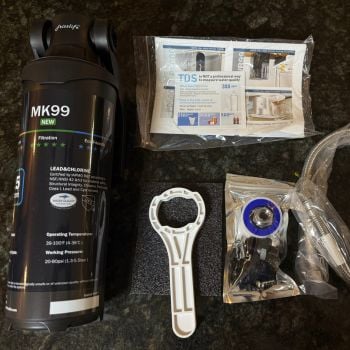
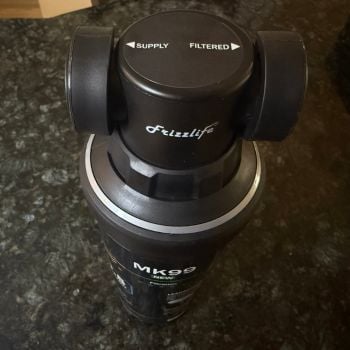
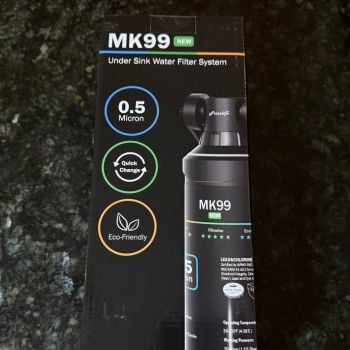
⏱️ Flow rate demo — filled 1 gallon in 38 seconds (≈1.65 GPM).
🧾 How It Scored
In hands-on testing, the MK99 delivered near tap-speed performance — a gallon in 38 seconds — while improving taste by stripping out chlorine bite and leaving minerals intact.
NSF/ANSI 42 and 53 certifications cover chlorine, lead, cysts, and VOCs, with components also compliant to 372.
Compared to the Waterdrop 15UA, it offers broader certified coverage at a slightly lower upfront cost, though the fittings feel less refined and filter life is shorter. The cartridges are rated for ~1,600 gallons (about 6–12 months), so upkeep comes more often than single-inline or multi-stage units.
Where it falls short: adapters are basic and lack O-rings, the warranty is just one year, and the design feels more utilitarian than polished. On the plus side, install was quick — under 15 minutes — and filter swaps are straightforward with minimal mess.
Filter life / annual cost: ~1,600 gallons; ~$120 per year.
Bottom line: Best for households that want strong flow and certified contaminant reduction at a budget price, and don’t mind shorter filter life or less-polished fittings.
#5. Aquasana Claryum 3-Stage
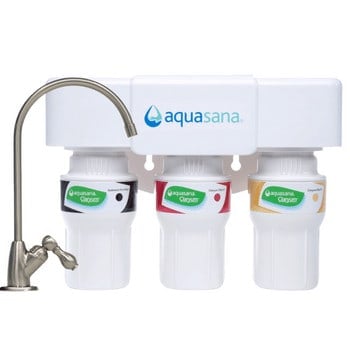
Scoring basis
- Filtration (Carbon) (40%): Certified to NSF/ANSI 42, 53, and 401. Targets chlorine, chloramine, lead, VOCs, pharmaceuticals, and pesticides. Skips fluoride.
- Flow/Pressure (20%): Keeps flow strong for a cartridge system
- faucet output is steady and reliable for daily kitchen use.
- Install/Maint (15%): DIY-friendly with included faucet. Filter-change alarm is useful, but cartridges only last ~600 gal (~6 months).
- Build (10%): Plastic housing feels less robust than premium competitors. Faucet available in three finishes adds flexibility.
- Taste (5%), Cost (5%), Certs (5%)
Aquasana Claryum — a certified 3-stage filter that targets city water’s biggest offenders.
Independently tested to NSF 42, 53, and 401, it covers chlorine, chloramine, lead, VOCs, and pharmaceuticals — though it skips fluoride. Flow is strong for a cartridge unit, and the included faucet with filter-change alarm is a nice touch.
What we like:
- Compact design — doesn’t eat up as much cabinet space as multi-stage rigs.
- Dedicated faucet keeps filtered and unfiltered water separate.
- Broad NSF coverage builds confidence for city water households.
What Could Be Better:
- Cartridges need replacing twice a year for most households.
- Build feels lighter than premium rivals; faucet is the nicest part.
- Customer support response times are hit or miss.
Best For: Households on city water that want broad NSF-certified protection in a compact under-sink system, without stepping up to full RO.
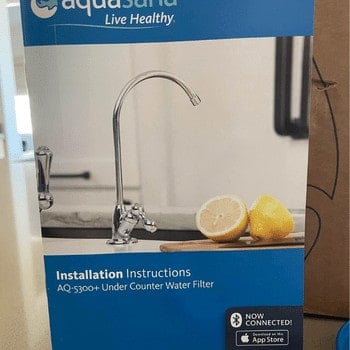
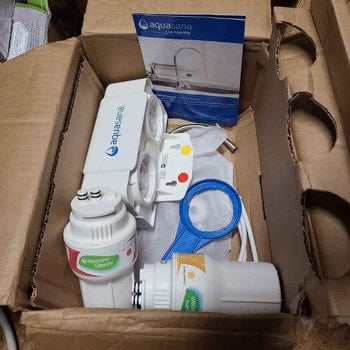

🧾 How It Scored
Independently certified to NSF 42, 53, and 401, the Claryum 3-Stage is proven to reduce 77 common contaminants including chlorine, lead, VOCs, and pharmaceuticals. Taste and odor improvements are immediate, though fluoride isn’t addressed.
Compared to Clearly Filtered, it’s easier on the budget and takes up less space, but doesn’t cover as wide a spectrum. Flow is strong for a cartridge system, especially with the included dedicated faucet, though filter life is shorter — about 600 gallons (~6 months).
Where it falls short: more frequent cartridge changes drive annual costs higher than some peers, and the plastic housing doesn’t inspire the same confidence as premium builds.
Filter life / annual cost: ~600 gallons; ~$240 per year.
Bottom line: Best for households that want a straightforward, certified under-sink system for city water, and don’t mind more frequent filter swaps.
📘 Buyer’s Guide
Undersink filters are less complex than costly whole-home systems, and unless you want to soften your water or need biological filtration, they offer a significant improvement in water quality and peace of mind without breaking the bank.
Compared to using filtration pitchers or bottled water, an under counter water filter will save you lots of money. Let’s dive in!
Understanding Water Contaminants
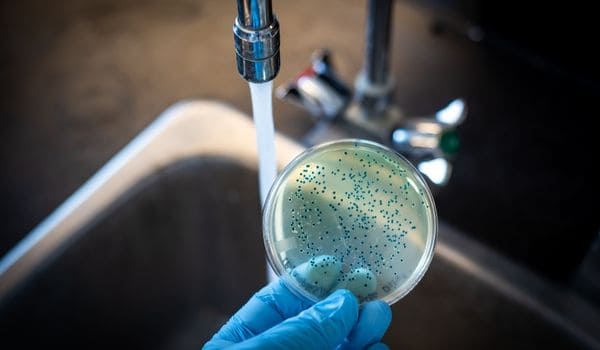
When you turn on your tap, you expect clean water, right? But often, what flows out carries more than just H2O. I’ve seen it firsthand – water that looks clear but carries hidden contaminants like chlorine, lead, and even microscopic nasties. Take chlorine, for example. It’s great for disinfecting, but it can leave your water tasting and smelling like a public pool. Not exactly what you want in your morning tea.
The Invisible Risks
And then there’s the stuff you can’t see. Lead, for instance, can leach from old pipes, and trust me, it’s the last thing you want in your drinking water. It’s sneaky and harmful, especially to kids. I’ve tested water in homes where lead levels were way above what’s considered safe, and it’s a game-changer for those families. Mercury, pesticides, herbicides – these aren’t just terms on a label. They’re real contaminants that I’ve seen affecting water quality, especially in certain areas or older homes.
Filtering Facts from Fiction
Here’s where a good water filter makes all the difference. I’ve installed and tested dozens, and I can tell you, not all filters are created equal. Some are like a fine net, catching only the big stuff, like sediment and chlorine. Others are more like a high-tech barrier, blocking even the tiniest pollutants, like lead or pharmaceutical residues.
The trick is knowing what’s in your water. I always recommend getting your water tested – it’s like getting a map before you start a journey. Once you know what you’re dealing with, picking the right filter is much easier. And believe me, there’s nothing quite like the peace of mind that comes from knowing your water is clean and safe, sip after sip.
Filter Certifications and What They Mean
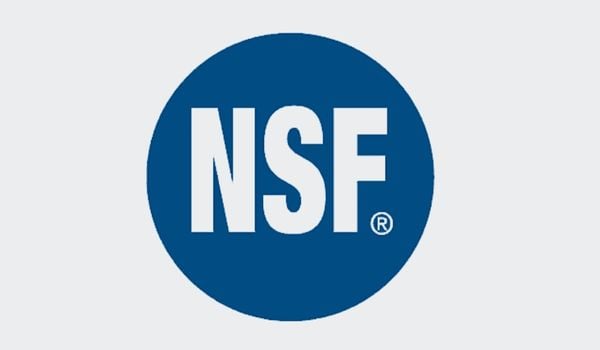
When it comes to water filtration, those certification labels aren’t just fancy stickers. They’re your assurance that what you’re buying isn’t just a glorified sieve. I’ve seen plenty of filters, but the ones that stand out always have certifications like ANSI/NSF.
ANSI/NSF – The Quality Markers:
Think of ANSI/NSF certifications as a filter’s resume. NSF/ANSI 42? It’s all about improving taste and reducing odor (hello, chlorine-free water!). NSF/ANSI 53, now that’s a big deal – it targets health-related contaminants like lead, mercury, and cryptosporidium. I always tell my clients, if you’re worried about what’s in your water, make sure your filter has this certification.
Beyond the Basics:
There are other certifications too, like NSF/ANSI 58 for reverse osmosis systems and NSF/ANSI 401 for emerging contaminants like pharmaceuticals. I’ve recommended NSF/ANSI 58 certified RO systems in areas with heavy contamination – they’re like a fortress guarding your water. And with more stuff ending up in our water these days, NSF/ANSI 401 is becoming a badge to look for.
The Bottom Line:
Certifications are a shortcut to understanding what a filter can really do. They’re not just about compliance; they’re about peace of mind. I always advise going for a filter with the right certifications for your specific water woes – it’s like choosing a doctor based on their expertise.
Capacity and Flow Rate
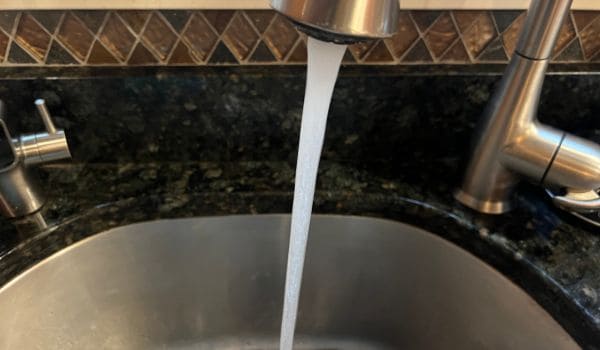
- Understanding the Basics:
- Capacity: Measures how much water your filter can purify before needing a replacement.
- Flow Rate: Indicates how quickly water flows through your filter.
- Why It Matters:
- Capacity:
- Essential for determining how often you’ll need to change the filter.
- Smaller families or single-person homes might opt for lower capacity.
- Larger households should consider higher capacity to avoid frequent changes.
- Flow Rate:
- Affects how fast you get your filtered water.
- Low flow rate can mean slow water delivery – think waiting for that morning coffee.
- Too high, and it might compromise the filtration effectiveness.
- Capacity:
- Finding the Right Fit:
- Daily Water Usage: Consider how much water your household consumes daily.
- Household Size: More people usually means more water usage.
- Patience for Filling Times: If slow filling is a no-go, aim for a higher flow rate.
- The Perfect Balance:
- Aim for a filter that matches your household’s water usage and expectations for speed.
- The right capacity and flow rate mean efficient filtering without frequent maintenance or waiting ages for a glass of water.
Installation and Maintenance
Installing an under-sink water filter might seem daunting, but it’s usually a straightforward task. According to ThisOldHouse ( my favorite show growing up), most homeowners can install these systems with basic tools and a bit of patience.
- Getting It Set Up:
- DIY-Friendly: Many under-sink filters are designed for easy installation. Think plug-and-play but for water.
- Tools & Time: Typically, you’ll need basic tools and about an hour. Always read the manual first – it’s like a treasure map to a smoother setup.
- Maintenance Must-Knows:
- Filter Changes: Mark your calendar! Regular filter changes are crucial for keeping water quality up.
- Keep an Eye Out: Watch for changes in taste, odor, or flow rate – they’re like little alerts that it’s time for maintenance.
- Pro Tips:
- Space Check: Before buying, ensure you have enough space under your sink. No one likes a surprise game of Tetris during installation.
- Follow the Flow: Make sure your system’s water flow matches your household’s rhythm. Slow flow when you’re rushing out the door? Not ideal.
Health and Environmental Benefits

The health and environmental benefits of using water filtration systems are well-documented. For instance, a study by the Water Quality Association highlights the effectiveness of these systems in reducing harmful contaminants.
- Sip Safe, Stay Healthy:
- Contaminant Reduction: Filters can significantly reduce harmful contaminants. Less lead, fewer worries.
- Healthy Hydration: Clean water means better hydration, and who doesn’t want that?
- Eco-Friendly Choice:
- Bottle-less Living: Ditch the plastic bottles. Under-sink filters are a win for the planet.
- Sustainable Savings: Over time, filters can be more cost-effective and eco-friendly than bottled water.
- Real-Life Impact:
- Taste the Difference: Ever noticed how filtered water just tastes better? It’s like upgrading from economy to first class, but for your water.
- Peace of Mind: Knowing your water is clean can be a huge relief. It’s one less thing to worry about in your busy life.
Cost Analysis
The average cost of an under-sink filter unit is $125, not including replacement filter costs, etc. When looking at long-term costs, you need to calculate what the true annual costs are.
For example, some filters need changing every 3-6 months, while others might require a filter change once every 6-9 months. Depending on the costs of the filter, that can add up fast!
Balancing Initial Investment and Long-Term Value
- Upfront Costs: While the initial cost might seem high, consider the superior filtration and longevity you’re getting compared to simpler filters.
- Maintenance Expenses: Factor in the cost of replacement filters. Regular maintenance is key to ensuring consistent water quality.
- Comparing to Bottled Water: Regularly purchasing bottled water? Add up that expense over a year, and you’ll see how an under-sink filter can be a cost-effective alternative, with the bonus of reducing plastic waste.
The Bigger Picture
- Health Savings: Better water quality can lead to improved health and potentially lower medical costs over time.
- Environmental Impact: Minimizing the use of bottled water not only saves money but also helps reduce your environmental footprint.
Aesthetic and Practical Considerations
The choice of an water filter isn’t just about water quality; it’s also a matter of enhancing your kitchen’s functionality and style.
Design and Functionality
- Space-Saving: These filters are out of sight, keeping your kitchen space uncluttered and your counters free.
- Faucet Styles: Accompanying faucets come in various designs, allowing you to complement your kitchen’s aesthetic while enjoying clean, filtered water.
Ease of Use
- Daily Convenience: Once installed, under-sink filters provide hassle-free access to purified water, eliminating the need for bulky pitchers or frequent bottle purchases.
- Accessibility: Designed for ease, these systems make getting clean water simple for everyone, ensuring a seamless flow of hydration for the whole family.
User Reviews and Experiences

Real-world feedback from users can provide invaluable insights into the performance and practicality of under-sink water filtration.
Gathering Genuine Feedback
- Performance in Action: User reviews often highlight how a filter performs day-to-day, from water taste improvements to maintenance ease.
- Long-Term Reliability: Look for comments on durability. How well does the filter hold up over months or years of use?
- Installation Experiences: First-hand accounts of installation can reveal how easy (or challenging) setting up the filter might be for DIYers.
Learning from Others
- Common Themes: Notice recurring praises or complaints? These can be crucial indicators of a filter’s overall quality and user satisfaction.
- Personal Stories: Sometimes, a user’s story can resonate with your own water concerns, helping you make a more informed decision.
Pros and Cons
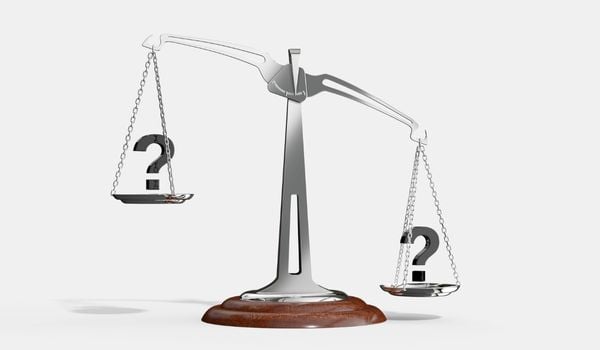
Diving into the world of water filtration, means weighing their benefits against potential drawbacks. These systems can be game changers, especially for those on a budget, or are living in a rental space where you can’t make serious alterations. So let’s weigh the pros and cons before going all in.
Pros:
- Top-Notch Water Purity: They excel at removing a wide range of contaminants, significantly improving the safety, taste, and odor of your water.
- Stealthy Space Savers: Tucked away under the sink, these units save precious counter space, maintaining your kitchen’s aesthetics.
- Long-Term Filter Lifespan: Designed for endurance, these filters require less frequent changes than pitcher or faucet-mounted types, making them convenient for busy lifestyles.
- “Set It and Forget It” Convenience: Once installed, they provide a constant supply of purified water directly from your tap, eliminating the need for manual refilling.
- Customizable Filtration: With a variety of models available, you can choose a system tailored to address specific contaminants in your water supply.
Cons:
- Installation Adventures: Installation can range from straightforward to complex, potentially requiring professional help if you’re not DIY-inclined.
- Upfront Investment: These systems generally come with a higher initial cost compared to simpler filtration solutions.
- Maintenance Matters: Periodic filter replacements are necessary and can be a bit daunting for those not used to DIY tasks.
- One-Spot Wonder: They filter water at a single point of use, typically the kitchen sink, leaving other faucets in your home unfiltered.
- Flow Rate Frustrations: Some models may reduce the flow rate of your tap water, which can be noticeable when filling large containers or during busy kitchen activities.
FAQ’s

- Do under-sink filters really improve water taste?
- Absolutely! They’re champs at reducing chlorine and other chemicals that make tap water taste like a swimming pool.
- How often do I need to change the filter?
- Depends on the model, but usually every 6 to 12 months. If your water starts tasting odd or the flow slows down, it’s time for a change.
- Can these filters remove lead?
- Yes, many can. But check the specs – you want something that specifically says it tackles heavy metals like lead.
- Will an under-sink filter work with my pull-out faucet?
- Tricky, but doable. Some filters come with kits for these types of faucets. Check before you buy.
- Do these filters waste water?
- Some types, like reverse osmosis, do use extra water. But many modern filters are pretty eco-friendly.
- Can an under-sink filter soften hard water?
- Not all of them. You’ll need a specific filter type for softening. Worth checking if hard water’s a headache at your place.
- Are under-sink filters better than pitcher filters?
- They filter more stuff and last longer between changes. So yeah, they’re like the superhero version of pitchers.
 115 people found this helpful. Was this guide helpful to you?
115 people found this helpful. Was this guide helpful to you? 

